Dagmar Schürrer reflects with her latest body of work »Where does the rest of the world begin?« (2024) on the deep entanglements of human consciousness, natural environment, and current technology. With a multimedia installation consisting of two digital animations, 3D prints and a Mixed Reality experience, she creates a spatial narrative in which she poetically links the scientific concepts of symbiosis and neural synchrony and applies those to our existence in the postdigital. Both theoretical approaches highlight the inter- connectivity of all organic and non-organic agents, challenging concepts of individuality, singular consciousness, and subjectivity. In this artistic engagement, the boundaries blur not only between digital and analog but also between human and technology, and thus between nature and culture. Thus, new media can be used in a way to promo- te a society characterized by fair coexistence, innovations, and the conscious use of technologies.
Text by Peggy Schoenegge
Read full exhibition text here >>>
Voice Over lyrics here >>>
This body of work was realized through the Pixel, Bites + Film scholarship of the Austrian Ministry of Culture.
The exhibition at SOMA was funded by the Austrian Culture Forum Berlin & BMKOES Austria
All installation shots by Max Zerrahn, during the solo exhibition SYMBIOTIC SYNCHRONY at SOMA Art Berlin in May/June 2024.
The works are fluid and can be shown in multiple ways and combinations. The three parts can be presented together or as individual installations.
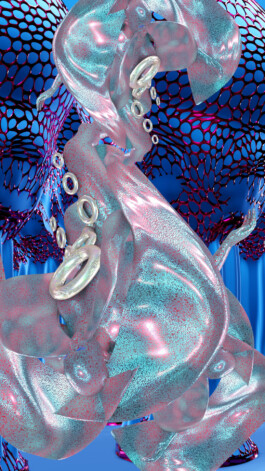
𝙒𝙝𝙚𝙧𝙚 𝙙𝙤𝙚𝙨 𝙩𝙝𝙚 𝙧𝙚𝙨𝙩 𝙤𝙛 𝙩𝙝𝙚 𝙬𝙤𝙧𝙡𝙙 𝙗𝙚𝙜𝙞𝙣? (𝙎𝙔𝙈𝘽𝙄𝙊𝙎𝙄𝙎)
2024, digital animation with sound, 11:30 min
Already in the 1990s, the microbiologist Lynn Margulis developed the concept of Symbiosis – the intimate »living together« of organisms – which is now recognized as a central driver of evolutionary innovation, complementing the opposing Darwinist theory of the »survival of the fittest«. The concept of Symbiosis is linked with the scientific theory of Neural Synchrony and transformed into a poetic and meditative Voice Over, which speculates about different scenarios of symbiosis and synchrony found in various combinations between humans, (micro)organisms, and technology.
Loosely at the center of the animation stands the character SYNTHIA, referring to the bacterium Mycoplasma laboratorium, which is the world’s first bacterium designed on a computer and assembled from scratch. SYNTHIA appears in different manifestations of hybrid avatar creatures embedded in a series of visual tableaus – computer generated animations of digital world building, that combine fantastical landscapes, abstract patterns, fragmented figures and microbial structures.
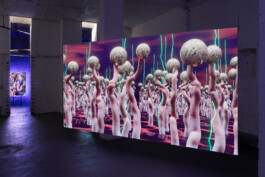
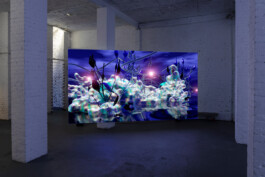
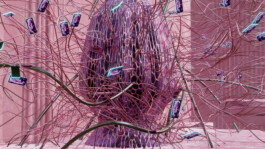
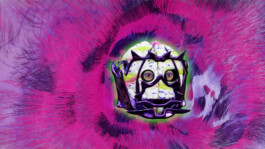
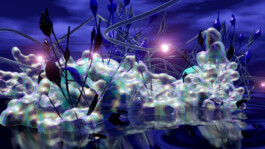
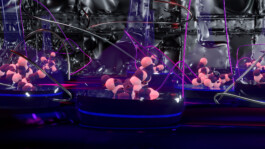
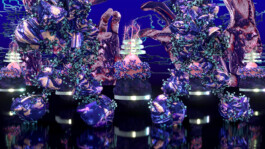
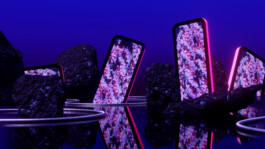
𝙒𝙝𝙚𝙧𝙚 𝙙𝙤𝙚𝙨 𝙩𝙝𝙚 𝙧𝙚𝙨𝙩 𝙤𝙛 𝙩𝙝𝙚 𝙬𝙤𝙧𝙡𝙙 𝙗𝙚𝙜𝙞𝙣? (𝙎𝙔𝙉𝘾𝙃𝙍𝙊𝙉𝙔)
2024, digital animation, 5 min, looped
At its core, the theory of Neural Synchrony suggests that neurons and brain activity can synchronize between two or more people through the consumption of similar (digital) media, social exchange, or the performance of common ritual acts. Some research proposes that (human) consciousness is the result of collaboration and synchrony and might be rooted in a form of »Hypermind« and not in singular individuals.
These concepts are visualized in the second large-scale projection in the exhibition, depicting the hybrid SYNTHIA avatars performing synchronized dance movements, continuously drifting in and out of seemingly abstract patterns, thus creating a hypnotic stream of repetition and collective ritual.
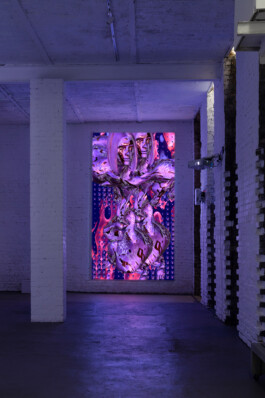
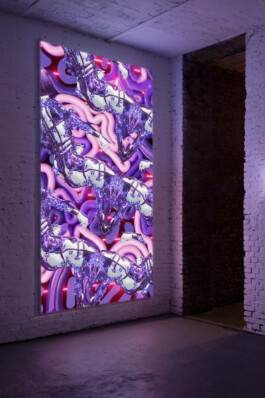
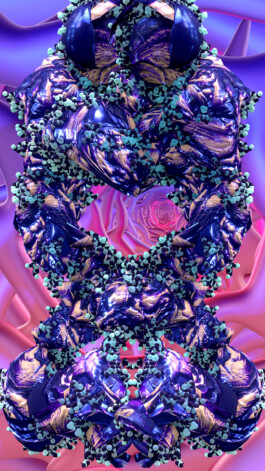

𝙒𝙝𝙚𝙧𝙚 𝙙𝙤𝙚𝙨 𝙩𝙝𝙚 𝙧𝙚𝙨𝙩 𝙤𝙛 𝙩𝙝𝙚 𝙬𝙤𝙧𝙡𝙙 𝙗𝙚𝙜𝙞𝙣? (𝙎𝙔𝙉𝙏𝙃𝙄𝘼’𝙎 𝘾𝘼𝙑𝙀)
2024, interactive Mixed Reality experience with sound and 3D prints
This part of the work extends the two animations into an interactive and spatial continuation of the narrative. Three analogue 3D printed sculptures, that visually reference the digital animations, are placed in the exhibition space and extended by a Mixed Reality environment.
In Mixed Reality (MR) the digital and analogue spheres merge almost seamlessly. A new generation of VR headsets allow the set up of digital spatial applications, while still seeing the analogue environment and each other. Here the users can interact and build their own hybrid clusters. While wearing a Quest 3 headset and moving freely in space, they can grab and move digital objects with their hands – playfully joining and separating them, building and rebuilding new combinations.
The 3D prints were realized with Alan Horsley of Bärenglas Berlin.
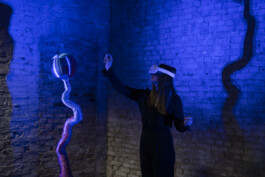

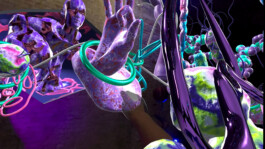
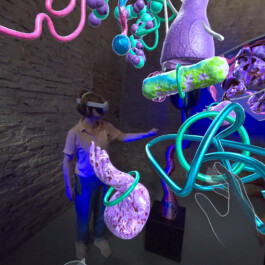
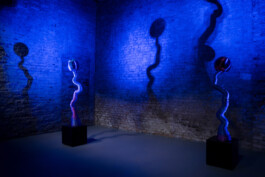


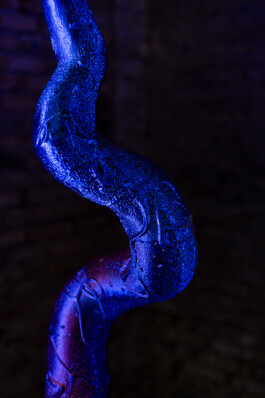
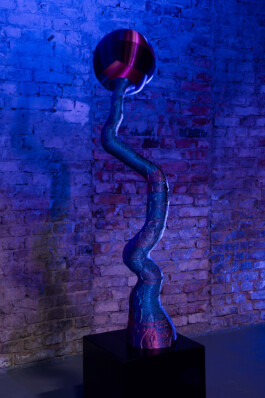

Dagmar Schürrer reflects with her latest body of work »Where does the rest of the world begin?« (2024) on the deep entanglements of human consciousness, natural environment, and current technology. With a multimedia installation consisting of two digital animations, 3D prints and a Mixed Reality experience, she creates a spatial narrative in which she poetically links the scientific concepts of symbiosis and neural synchrony and applies those to our existence in the postdigital. Both theoretical approaches highlight the inter- connectivity of all organic and non-organic agents, challenging concepts of individuality, singular consciousness, and subjectivity. In this artistic engagement, the boundaries blur not only between digital and analog but also between human and technology, and thus between nature and culture. Thus, new media can be used in a way to promo- te a society characterized by fair coexistence, innovations, and the conscious use of technologies.
Text by Peggy Schoenegge
Read full exhibition text here >>>
Voice Over lyrics here >>>
This body of work was realized through the Pixel, Bites + Film scholarship of the Austrian Ministry of Culture.
The exhibition at SOMA was funded by the Austrian Culture Forum Berlin & BMKOES Austria
All installation shots by Max Zerrahn, during the solo exhibition SYMBIOTIC SYNCHRONY at SOMA Art Berlin in May/June 2024.
The works are fluid and can be shown in multiple ways and combinations. The three parts can be presented together or as individual installations.

𝙒𝙝𝙚𝙧𝙚 𝙙𝙤𝙚𝙨 𝙩𝙝𝙚 𝙧𝙚𝙨𝙩 𝙤𝙛 𝙩𝙝𝙚 𝙬𝙤𝙧𝙡𝙙 𝙗𝙚𝙜𝙞𝙣? (𝙎𝙔𝙈𝘽𝙄𝙊𝙎𝙄𝙎)
2024, digital animation with sound, 11:30 min
Already in the 1990s, the microbiologist Lynn Margulis developed the concept of Symbiosis – the intimate »living together« of organisms – which is now recognized as a central driver of evolutionary innovation, complementing the opposing Darwinist theory of the »survival of the fittest«. The concept of Symbiosis is linked with the scientific theory of Neural Synchrony and transformed into a poetic and meditative Voice Over, which speculates about different scenarios of symbiosis and synchrony found in various combinations between humans, (micro)organisms, and technology.
Loosely at the center of the animation stands the character SYNTHIA, referring to the bacterium Mycoplasma laboratorium, which is the world’s first bacterium designed on a computer and assembled from scratch. SYNTHIA appears in different manifestations of hybrid avatar creatures embedded in a series of visual tableaus – computer generated animations of digital world building, that combine fantastical landscapes, abstract patterns, fragmented figures and microbial structures.








𝙒𝙝𝙚𝙧𝙚 𝙙𝙤𝙚𝙨 𝙩𝙝𝙚 𝙧𝙚𝙨𝙩 𝙤𝙛 𝙩𝙝𝙚 𝙬𝙤𝙧𝙡𝙙 𝙗𝙚𝙜𝙞𝙣? (𝙎𝙔𝙉𝘾𝙃𝙍𝙊𝙉𝙔)
2024, digital animation, 5 min, looped
At its core, the theory of Neural Synchrony suggests that neurons and brain activity can synchronize between two or more people through the consumption of similar (digital) media, social exchange, or the performance of common ritual acts. Some research proposes that (human) consciousness is the result of collaboration and synchrony and might be rooted in a form of »Hypermind« and not in singular individuals.
These concepts are visualized in the second large-scale projection in the exhibition, depicting the hybrid SYNTHIA avatars performing synchronized dance movements, continuously drifting in and out of seemingly abstract patterns, thus creating a hypnotic stream of repetition and collective ritual.




𝙒𝙝𝙚𝙧𝙚 𝙙𝙤𝙚𝙨 𝙩𝙝𝙚 𝙧𝙚𝙨𝙩 𝙤𝙛 𝙩𝙝𝙚 𝙬𝙤𝙧𝙡𝙙 𝙗𝙚𝙜𝙞𝙣? (𝙎𝙔𝙉𝙏𝙃𝙄𝘼’𝙎 𝘾𝘼𝙑𝙀)
2024, interactive Mixed Reality experience with sound and 3D prints
This part of the work extends the two animations into an interactive and spatial continuation of the narrative. Three analogue 3D printed sculptures, that visually reference the digital animations, are placed in the exhibition space and extended by a Mixed Reality environment.
In Mixed Reality (MR) the digital and analogue spheres merge almost seamlessly. A new generation of VR headsets allow the set up of digital spatial applications, while still seeing the analogue environment and each other. Here the users can interact and build their own hybrid clusters. While wearing a Quest 3 headset and moving freely in space, they can grab and move digital objects with their hands – playfully joining and separating them, building and rebuilding new combinations.
The 3D prints were realized with Alan Horsley of Bärenglas Berlin.










